The Allan Line: Pioneers of Transatlantic Steamship Travel and Immigration
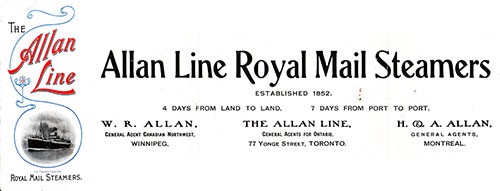
The Allan Line operated steamships that covered Transatlantic routes between ports in the United Kingdom (Glasgow, Londonderry, Belfast, Liverpool, and London) to North American Ports of Call. Canadian Ports served included Quebec, Montreal, St. Johns, and Halifax. US Ports included: Portland, Boston, New York, Philadelphia, and Baltimore.
Allan Line Collection Includes Passenger Lists, Immigrant Landing Cards, Postcards, Menus, Passage Contracts and Tickets, Brochures, Concert Programs, Immigrant Inspection Cards, and Books.
Content Links
- Ships and Ocean Liners Archival Collection
- Postcard Archival Collection
- Books In Archival Collection
- Tourist and Pleasure Travel Unequalled Advantages - 1894
- The Allan Line's Turbine Steamships To Canada - 1904
- History of the Allan Royal Mail Line of Steamers - 1914
- Romance of a Great Transatlantic Line - 1912
- Allan Line's Long and Notable Career - 1919
Allan Line Archival Collections
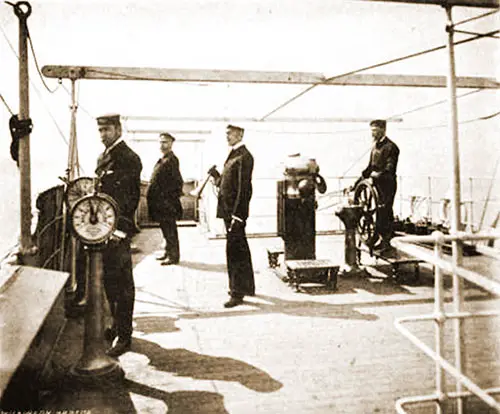
Pilot on the Navigating Bridge of an Allan Liner. The Vessel Is in Narrow Waters, and Her Commander, Reinforced by One of His Officers and the Man at the Wheel, Is at His Post While the Pilot Is Ready With His Megaphone to Give His Orders to Those in the Bows of the Ship. The Picture Is a Striking One and Possesses Great Value since It Depicts an Incident in Nautical Routine; those Actors Who were intent on Bringing the Ship to an Anchorage Had No Idea That the Omniscient Eye of the Camera Was Upon Them. The Syren and Shipping, 27 April 1904. | GGA Image ID # 213f8f62c1
Return to Content Links
Everything Ship Related can be found under the Ships and Ocean Liners Archival Collections. Typically, this includes Advertisements, Autographs, Back Cover Images, Brochures, Cab Tally/Cap Ribbons, Deck Plans, Information for Passengers, Fleet Lists, Guides, Illustrations and Paintings, Immigrant Documents, Luggage Tags, Machinery-Engines-Equipment, Menus, Officers Sleeve Stripes, Passage Contracts-Tickets-Receipts, Passage Rates, Passenger Inscriptions, Passenger Lists, Photographs, Postcards, Posters, Programs, Publications, Route Maps-Track Charts-Abstract of Logs, Sailing Schedules, Services, Speed Records, Stationery, Title Pages, Sheet Music, Videos, and Other Ephemera is Located in This Section.
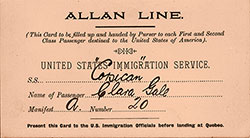
RMS Corsican Archival Collection
Ephemera for the RMS Corsican available may include Passenger Lists, Menus, Brochures, Sailing Schedules, Route Maps, Photographs, and more.
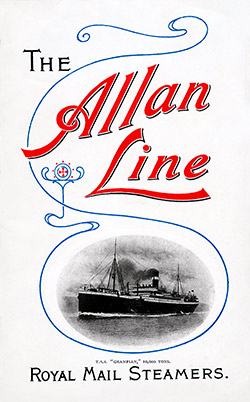
SS Grampian Archival Collection
Ephemera for the SS Grampian available may include Passenger Lists, Menus, Brochures, Sailing Schedules, Route Maps, Photographs, and more.
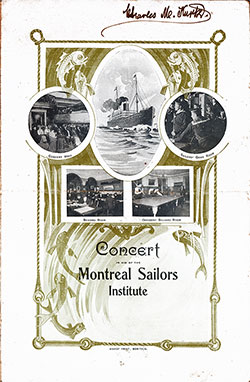
RMS Hesperian Archival Collection
Ephemera for the RMS Hesperian are available at the GG Archives, including Programs, Advertisements, Launch History, Sinking, and more.

Ephemera for the SS Ionian available may include Passenger Lists, Menus, Brochures, Sailing Schedules, Route Maps, Photographs, and more.
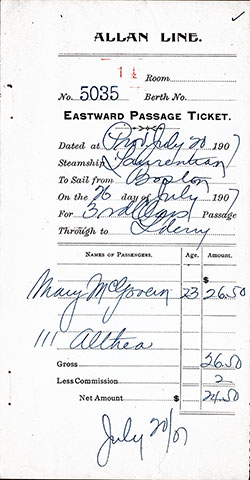
SS Laurentian Archival Collection
Ephemera for the SS Laurentian available may include Passenger Lists, Menus, Brochures, Sailing Schedules, Route Maps, Photographs, and more.

SS Parisian Archival Collection
Ephemera for the SS Parisian available may include Passenger Lists, Menus, Brochures, Sailing Schedules, Route Maps, Photographs, and more.

RMS Pretorian Archival Collection
Ephemera for the RMS Pretorian available may include Passenger Lists, Menus, Brochures, Sailing Schedules, Route Maps, Photographs, and more.
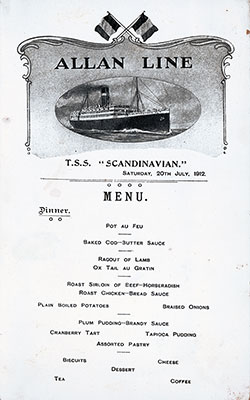
SS Scandinavian Archival Collection
Ephemera for the SS Scandinavian available may include Passenger Lists, Menus, Brochures, Sailing Schedules, Route Maps, Photographs, and more.

SS Tunisian Archival Collection
Ephemera for the SS Tunisian including Passenger Lists, Brochures, Sailing Schedules, Postcards, Advertisements, Books, and more.

RMS Victorian Archival Collection
Ephemera for the RMS Victorian available may include Passenger Lists, Menus, Brochures, Sailing Schedules, Route Maps, Photographs, and more.

SS Virginian Archival Collection
Ephemera for the SS Virginian available may include Passenger Lists, Menus, Brochures, Sailing Schedules, Route Maps, Photographs, and more.
Return to Content Links
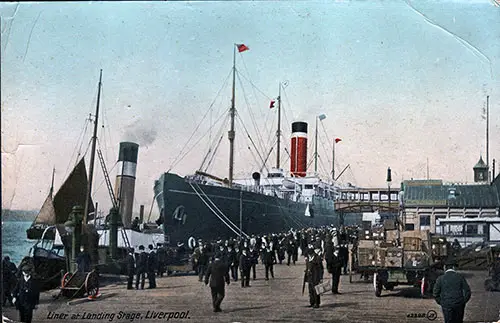
Allan Line Steamer Docked at the Liverpool Landing Stage. GGA Image # 71689ba5ef
Return to Content Links
- The Great Liners: The Seafarers, Volume 4
- Great Passenger Ships of the World 1858-1912
- Leviathan: "The World's Greatest Ship" Volume 1
- Morton Allan Directory of European Passenger Steamship Arrivals
- Ocean Liner Collectibles
- Passenger Ships of the World - 1963
- Ravenscrag: The Allan Royal Mail Line
- Steamships and Their Story
- Transatlantic and the Great Atlantic Steamships
Return to Content Links
Montreal and Quebec Service
The Steamship of the ALLAN LINE leaving Montreal and Quebec or returning from Liverpool, make the transit of the ocean from land to land in five to five and one half days.
The distance from Quebec to Liverpool is 500 miles shorter than from New York, and 1,000 miles of this reduced distance (from Quebec to the Straits of Belle Isle) is down the majestic river and gulf of St. Lawrence, and instead of seasickness, to which the traveler is liable by all other routes, and the monotony of an ocean voyage, the traveler, by this line, enjoys the first three days of the voyage in good health. such being made in smooth water, and is entertained in viewing the magnificent and historic scenery of the St. Lawrence.
The steamships of the ALLAN LINE performing passenger service, such as the " Parisian," " Sardinian," " Mongolian," " Laurentian " and " Numidian," are equaled in safety and comfort by few trans-atlantic vessels, and surpassed by none.
The discipline practiced upon these ships is as systematic and thorough as that of the Royal Navy, the finest school for seamanship in the world.
The ALLAN LINE enjoys the distinction of the patronage of Her Royal Highness the Princess Louise, who has selected a steamer of this line upon four successive voyages.
EXCURSION TICKETS are good for either outward or return by the Quebec or New York Lines.
Passenger Accommodations - Cabin
State Rooms are mostly on the upper deck, the majority of the rooms having two berths, and a sofa, which may be used as a berth when necessary.
Rates of passage are fixed according to location of berth, all passengers having equal privileges in the saloon.
The ALLAN LINE has always been well known for the excellence and Iiberality of its table, which is always provided with the delicacies of the season.
Wines and liquors of the finest qualities can be had on board at moderate prices.
All the steamers carry an experienced surgeon.
Passenger Accommodations - Intermediate or Second Cabin
This class of accommodation ofl'ers excellent opportunity to those desirous ofmaking a trip in a most comfortable manner at an extremely small outlay.
Passengers are berthed in state rooms generally accommodating four persons, are entirely separate from the steerage, and are furnished with a liberal supply of food, well cooked and neatly served. Beds napery and utensils are all furnished by the steamer.
Passenger Accommodations - Steerage
The Steerage, considering its cost, is remarkable for its comfort, the utmost regard having been paid to the light and ventilation of the Steamers. Male steerage passengers are berthed by themselves in one part of the ship, females and children in another.
New Departure
The Company will furnish all its steerage passengers to and from Europe with a complete outfit for the voyage free of charge.
Baggage Allowance
Cabin passengers are allowed 20 cubic feet; Intermediate, 15 cubic feet, and Steerage Io cubic feet; any excess will be charged for at the rate of one shilling per cubic foot. All baggage should be labeled with name of passenger and marked "wanted" or " not wanted" as may be desired by the owner.
-- 1894 Advertisement of the Allan Line.
Return to Content Links
How to get to Canada? Why nothing is more easily done. Book your passage on the Allan Line from Liverpool, Glasgow, or Londonderry, pay your fare, and Allan. Bros. and Co. will do " all the rest."
Pioneer of Canadian Transatlantic Service
The Allan Line has been the pioneer of the Canadian Atlantic Ferry from the very first. The birth, growth, and development of this line are inseparably associated with the history of Canada.
The Allan's were Scotchman, but they had in them the reincarnated soul of Cabot and his three sons, who, more than four hundred years ago, first carried the English flag up the Gulf of St. Lawrence.
It is curious to see how little Englishmen have done to discover and develop Canada. What is now the Canadian Dominion was first discovered in 1497 by a Venetian. The Portuguese followed, but beyond kidnapping some Indians for slaves, they did nothing to develop the country.
Then came some Bretons from Brittany, who left Cape Breton on the map as a souvenir of their visit. After them, a Florentine and a Spaniard, in the service of the French King, annexed the country somewhat under the fashion of De Brazza, with his pocket-handkerchief treaties, and afterward, it was first opened up to European colonization by a Frenchman, Jacques Cartier.
In our days it was an Irishman who crushed the Red River revolt, a native of Glasgow who founded the Mc Gill University. When Canada became a Dominion, both her political leaders, Macdonald and Mackenzie, were Scotchmen.
Lord Strathcona is a Scotchman, and it is but in accordance with the record of the Dominion that the Canadian Ferry should have been front the first to last in the hands of Scotchmen.
Seven years after the battle of Waterloo, Alexander Allan, captain of the brig Fean, sailed from Glasgow for Quebec. No one paid much attention to the voyage.
The brig Fean was, however, in its way worthy of ranking with the caravels of Columbus and of Cabot, with the mythic -Argo - mud and the sacred Mayflower. For that tiny vessel, whose tonnage was not one-fiftieth part of the Victorian, was the progenitor of the Allan Line, one of the most famous of the mercantile fleets of the Empire.
The seed sown in 1822 did not spring up very quickly. In 1830 the Fean had been succeeded by four sailing vessels, which regularly plied between Canada and the British ports. It was not till 1852 that the first attempt was made to establish a Canadian steam ferry.
The Canadian Government entrusted the task to a firm which promised well, but performed so severely, that before a twelvemonth was over they were glad to hand the responsibilities over to Messrs. Allan, who, in 1853, began a fortnightly service between Liverpool and Québec and Montréal in the summer months, and Liverpool and Portland, Maine, in winter time.
The First Allan Line Mail Steamers
Their first mail steamer which, like all the early steamers, carried sails, was the two-funneled Canadian, of about moo tons burden. In 1858 the fortnightly service was found to be inadequate.
The Allan line in that year started a steamer every week, and have kept it up ever since. The ships have grown bigger and bigger every decade. One of the crack linen today is as large as seven Canadians of fifty years ago, and still, the limit of size is not reached.
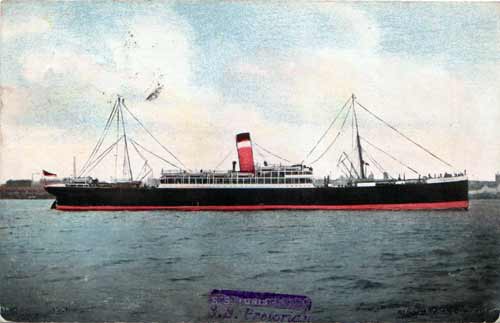
Allan Line TSS Tunisian - 10,567 Tons. | GGA Image ID # 20b0464b2d
It has been the pride of the Allan Line to be pioneers of all the improvements that modern science and modern ingenuity can suggest for increasing the speed or of improving the comfort of the Transatlantic service.
They were not only the pioneers both of the sailing and the steamship ferry between Canada and Britain, but they were also the first to adopt many of the most valuable improvements in the construction of liners.
The New Turbine Driven Twin-Screw Steamships
And now this famous line is about to forge ahead once more. They have beaten all their rivals in utilizing the turbine for ocean liners of the first class.
Their new turbine steamer the Victorian will be on the ferry at the beginning of 1905, and she will be very shortly joined by her sister-ship the Virginian. It is noteworthy that neither of these vessels has been built in England.
The Victorian was built at Belfast. The Virginian on the Clyde. There is little doubt that the turbine is destined to supersede the marine engine.
Admiral Fisher prophesied last year that in five years time the whole British navy would be turbine-driven. The same considerations which have led to its adoption in private yachts will compel its adoption on all passenger steamers.
Sir George Newnes's new yacht, now being built on the Tyne, will be driven by turbines, not so much for speed as because the adoption of the turbine liberates so much space that every passenger can have a four-post bed in his cabin, and the passages are broad enough for three men to walk abreast. The new Cunarders will be fitted with turbines.
But while the turbine Cunarders are building, the Allan Line turbine steamer is in the water. Increased speed, diminution of attendance, the economy of space, absence of vibration, a reduction of weight, utilization of the last ounce of steam power, and less danger of breakdown—these are the advantages which are enabling the turbine to kill out the reciprocating engine.
The Allan Line SS Victorian
The Victorian is a vessel of 12,000 tons register. Its capacious hold will carry 8,000 tons deadweight of cargo, besides 1,300 passengers. It will be driven at the rate of from eighteen to twenty knots an hour by three propellers, which will be rotated at from 270 to 300 revolutions per minute by one high-pressure and two low-pressure Parson's turbines.
The side screws are worked by the low-pressure turbines and have a reversing arrangement which enables them to be driven full speed astern either together or independently. By this means the Victorian and Virginian will be as much under command for backing or turning as any ordinary steamship.
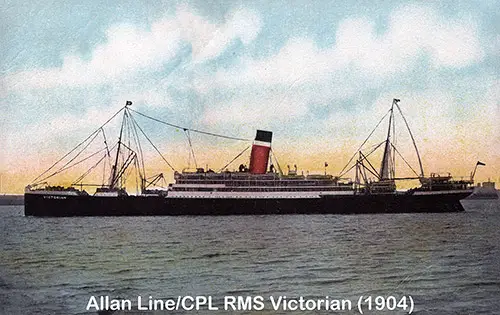
Allan Line/Canadian Pacific Line RMS Victorian (1904). | GGA Image ID # 20b04d1b3d
It is almost impossible to explain the mystery of the turbine to the ordinary reader. The main idea of it is that the steam instead of driving a piston backward and forwards and rotating the shaft of the propeller is passed directly into a cylinder, within which there turns a massive drum weighing ninety-five tons, built on the shaft of the propeller.
Between the drum and the cylinder, down a devious path obstructed by flanges or rings of brass blades, the steam rushes impetuous from the boilers, and as it can only get out by thrusting the drum round, the screw is by this means made to rotate.
The marvel and the mystery—we might also say the miracle —consist in the number and exactitude of the brass blades which guide the steam. They are tiny, fragile-looking points, not more substantial than a lady's little finger. But there are no less than one million and a-half used in the three turbines in the Victorian.
There are no moving parts to break or to get out of order, and everything depends upon the proper " set " and inclination of the two sets of blades. The energy of the steam is used up to the last ounce in its passage through the turbine.
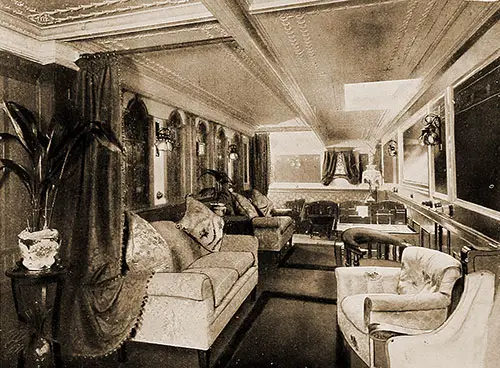
Ladies Boudoir on the TSS Victorian, Plate XLIV Every Boys Book, 1911. | GGA Image ID #
The Allan liners the Tunisian and the Bavarian have long been famous for their comfort, convenience, security, and stability. It is expected that the Victorian and the Virginian will be all that these crack boats have been, only more so.
On these steamers, instead of utilizing the space economized by the turbines to carry more passengers, it has been used to increase the comfort and luxury of the accommodation.
The length of the Victorian is 540 feet; her breadth 6o feet; her depth 40 feet 6 inches. She is divided by bulkheads into eleven compartments, and with the subdivisions of her double-bottom, she has twenty watertight spaces.
She is built to the highest class of the British Corporation Registry of Shipping, and her hull has been specially strengthened above the requirements of the Corporation to make her doubly secure against the heavy weather of the North Atlantic.
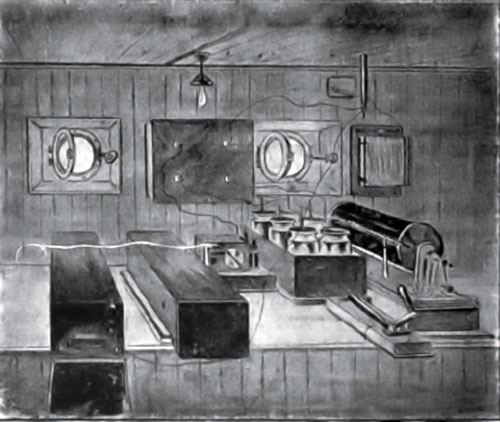
Marconi Wireless onboard an Allan Line Steamship. Review of Reviews, December 1904. | GGA Image ID # 20b0ed8db0
The first-class accommodation, which, as usual, is amidships, is of the most complete and approved order. Perfectly heated and ventilated staterooms and suites of rooms, a spacious and well-fitted dining-saloon, an elegantly appointed music-room, and a luxuriously equipped smoke room are some of the features.
Not less comfortable proportionately are the second-class quarters, and, as already indicated, third-class passengers are catered for most liberally.
Electric light throughout, a complete printing outfit, and installation of Marconi's wireless telegraphy are among the arrangements for the comfort and convenience of passengers.
Allan Line One of the Most Popular Atlantic Lines
The enterprise and the caution of the Allan Line, and the comfort of their boats combine to make their Canadian Ferry one of the most popular of the Atlantic lines. But they have got an immense advantage over all their competitors in the fact that they command the shortest sea route.
From Liverpool to Londonderry the liners are almost in land-locked waters. And they are again within the solid grasp of the shore when they reach Belle Isle Strait.
They thus cut the open ocean voyage down to 1,650 miles, and this they cover in four days and a half. The first European keels that plowed the waters of the St. Lawrence were those of the caravels of John Cabot, who was sent out by the citizens of Bristol to discover the North-West passage to far-away Cathay.
A whole continent barred the path of the adventurous navigator. But that continent has now been bridged by the iron road, and the swiftest route to the fair East now lies along the track of the early navigator.
When Jules Verne's traveler tries to cut the record for a round-the-world journey, he will, when peace is restored in Manchuria, always take Canada en route.
This is the shorter route. The scenery en route is much more interesting than that on the American lines, as the Scottish landscape is more romantic than English.
Connections between England and Canada
Whether the voyager disembarks at Quebec, Montreal, or Halifax, Messrs. Allan's steamers connect in each case with the systems of the Canadian Pacific and the Grand Trunk Railways, so that the passenger can, before he sets foot on ship-board, be booked through to any point in British North America or the United States.
At the ports named, the steamship piers are adjacent to the railway stations, so that the passenger and his effects are entrained without delay, and, what is equally important, without the slightest extra expense.
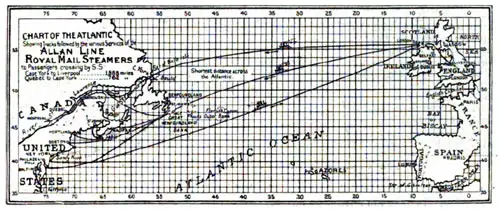
Chart of the Atlantic showing the routes used by the Allan Line between England and Canadian Ports.
The traveler from London is taken directly to the landing-stage at which the steamer is lying. The Liverpool sailing day is Thursday and the time 3.30 p.m. in the winter, and 4.30 p.m. during the summer months.
Thus the London passenger can leave the Metropolis at noon, lunch en route in the train, and have dinner in the Irish Sea, so nicely dove-tailed are the sailing arrangements.
It's The Little Things That Count Too
As to the table kept on the Allan steamships, the traveling public has long appreciated its excellence and variety, the menu is equal to that of a first-class hotel, and the service of the very best.
Breakfast is served from 8.30 to 10 a.m., luncheon at 1.30 p.m., and dinner at 7 p.m., and such little make-shifts as afternoon tea and supper as passengers desire them.
Afternoon tea is quite a function on hoard an Allan Liner, the ladies holding their levies and expecting the attendance of the gentlemen just as if they were in their own drawing-rooms.
The Allan Line is one of the strongest links in the chain that unites the Dominion with the Realm. It has converted that which divided and estranged, by a spacious, pleasurable, and health-giving moving ferry, into an element which unites.
For as Wordsworth so finely sang at the beginning of the century, when the silent highway of our ocean Venice was as yet unploughed by the propeller, as the bees swarm through the air.
"The Allan Line, and Their Turbine Ferry To Canada," in The Review of Reviews, Volume 30, December 1904, Pages 683 - 686.
Return to Content Links
Hugh Allan arrived as a boy in Montreal, sailing from Greenock in Scotland with his father on the brig Favorite. We can imagine the scene of landing from the state of the development of the port at that time.
Hugh went into business as a bookkeeper to William Kent & Company, but in 1831 he entered the office of Messrs. William Edmonstone & Company, ship agents and shipbuilders. Andrew, his brother, joined him later and they both married sisters, daughters of R. John Smith, a wealthy importer.
These two brothers represented the Allan line in Montreal, while Glasgow and Liverpool were served by the three other sons. Meanwhile the Allan fleet, especially since 1834, had been growing with such ships as the clippers Glennifer, Abeona, the Corinthian, and their first steamship Sardinian, of which Captain Dutton, a religious-minded but capable seaman, known as "Holy Joe," was the commander, afterward becoming the commodore of the fleet.
The firm now owned a fleet of fast sailing vessels of about three hundred and fifty tons register—full-rigged ships which, with ice-blocks around their bows, pushed their way through the ice, so that sometimes they would arrive in port on the 15th of April.
In 1853 Mr. Hugh Allan, who was a man of great tenacity of purpose, and at the same time of remarkable foresight, saw that the time had come for the building of iron ships for the St. Lawrence trade. Besides, there was the consideration that they would run to Portland in the winter time, and connect with Montreal by rail.
He enlisted the support of several wealthy men, including Mr. William Dow and Mr. Robert Anderson, of Montreal, and formed the Montreal Ocean Steamship Company. The Canadian and Indian were the first two boats built by the company.
The boats cost about two hundred and fifty thousand dollars each and had a speed of eleven knots.
They were wonders at the time and made a great impression, as the people had not been accustomed to seeing iron ships. Thus it happened that when about this time the Crimean war broke out, and the government was at its wit's end to provide transports, the Allans went into the business, and while the war lasted made substantial profits.
Contract with the Canadian Government
The Canadian Government now made a contract with Mr. Hugh Allan for carrying the mails, paying an annual subsidy of $120,000 per annum. The Anglo-Saxon, a new boat, ran from Quebec to Liverpool in nine days on one occasion. This was thought to be fantastic, as the people had been accustomed to a voyage of forty days on the old sailing vessels.
At that time the ships got 30 cents per bushel for carrying grain. Contrast this with the 2 cents of today, or the carrying of grain for nothing, as is done by New York shipping at certain periods of the year, to get ballast on an outgoing trip.
The requirements of the service in 1858 demanded more accommodation, and the Allan brothers determined to run on a weekly service.
Larger and faster boats were introduced. The government paid subsidies to the new service totaling $416,000 per annum. Year by year the Allans launched new boats, always bigger and faster, though speed was never the chief consideration with the company.
In 1861 they had a fleet of over twenty vessels, but a lousy fortune befell the company in the first ten years of its existence. Eight ships were lost in as many years.
In 1857 the Canadian, in 1859 the Indian, in 1860 the Hungarian and the second Canadian, and the North Briton in 1861, and later the Anglo-Saxon, the Norwegian and the Bohemian—all became total wrecks.
The river was poorly lit, and the tides did not run right. The pilots were incompetent. The compass deviated, owing to some strange local attraction due, it was said, to mineral deposits in the gulf. Anyway, disaster followed disaster, and, as was announced at the time, any other man than Mr. Allan would have given up in despair.
But that gentleman had something of the firmness of his native granite in his composition, and he never wavered. Difficulties in time were overcome; the Allans began to prosper and from this on their boats were singularly free from accidents.
However, to show how little even the most perceptive can see in advance of their time, it may be stated that at the banquet which the citizens tendered Mr. Hugh Allan in 1850, he said that ships of 1,700 tons were the most suitable for the Montreal trade. He lived to see his boats grow to 5,500 tons.
The line prospered; the number of boats was increased continuously to meet the need; the Northwest was opened up, and the Allan boats brought in many thousands of immigrants. Also, the company branched out to South America.
The building of the Parisian in 1881 was supposed to be about the last word in shipbuilding. She was far in advance of anything to be seen on the route. Today she is, by comparison with the leviathans of the route, almost as antique as the old Favorite was when steamships came in.
In 1887, the Canadian Government decided to subsidize a line of fast steamships. They asked for twenty knots an hour and that the vessels should call at a French port.
The Allans held that the first demand was impracticable since high speed would be dangerous because of the fogs in the gulf; while, as to the second, it was deemed to be out of the question.
The Government played with a tender from another firm, Anderson, Anderson & Co., of London, which, however, did not come to fruition; and the fast Atlantic service, in spite of much discussion and tentative efforts on the part of the Government and the shipping people, has never come to anything to this day. The C. P. R. offered to build a fast service, but the terms were deemed by the government to be too harsh.
The line increased, however, in ships, in business done, in reputation, both from our own and the American ports.
Mr. Hugh Allan was knighted in 1870. In 1877 he determined to associate his name with the C. P. R. enterprise. He, in fact, formed the first syndicate to build it. The fall of the Macdonald Government defeated his plan.
He succumbed to an attack of gout in 1882, at the age of seventy-two years. His remains were brought out to Canada in one of his own ships and laid to rest in Mount Royal Cemetery.
Alexander Allan died, at Glasgow in 1892, leaving a fortune of three million dollars. Andrew, so well remembered by Montrealers for his public spirit, his identification with good works, his "canny" Scotch caution, compatible, at the same time, with an enterprise and boldness in the conduct of his business, died in Montreal in the '90s.
The business today is carried on by Mr. Hugh A. Allan, chairman, resident in London, and Mr. Andrew A. Allan, vice chairman, resident in Montreal.
The Fleet of the Allan Line
The firm has broadened out in many important ways. It was the first to introduce turbines on the St. Lawrence, and it is still augmenting the fleet.
Of the Allan fleet, the steamers on the Montreal-Quebec-Liverpool service making the port of Montreal are Tunisian, 10,576.38 tons; Victorian, 10,629.09 tons; and Virginian, 10,569.62 tons.
The steamers on the Montreal and Glasgow line are Corsican, 11,436 tons; Grampian, 10,900 tons: Scandinavian and Hesperian, 12,100 and 10,900 tons respectively.
Those in the Montreal and London service are Ionian, 8,267.61 tons; Sicilian, 6,229.49 tons: Scotian, 10,490 tons: Corinthian, 6,229.49 tons; and Tunisian. 10,576.38 tons.
Those in the Montreal and Havre service are Ionian, 8,267.61 tons; Scotian, Corinthian, Sicilian, 6,229.49 tons; and Tunisian, 10,576.38 tons.
The Introduction of Liverpool Service
The year 1914 also saw the introduction to the Liverpool service of the Allan Line the new steamers Alsatian and Calgarian, quadruple screw turbine steamers, ships of 18,000 tons, 21 knots speed, the largest, fastest and most luxuriously equipped steamers on the St. Lawrence route.
Among the great mercantile fleets of the world, no house flag is better known than the red pennant and tri-color of the Allan Line, and none represents to the ocean voyager a higher degree of safety and comfort.
To the Allan Liner Corsican, Captain John Hall belongs the honor of being the first ocean liner to make the port of Montreal in 1914, arriving here at 12:30 p.m. in., Wednesday, April 29th.
Following the time-honored custom, Captain Hall was presented by the Harbor Commissioners with a gold-headed cane and a silk hat.
Excerpt from Atherton, William Henry, Ph.D. Montreal, 1535-1914 Under British Rule, 1760-1914, Volume II, The S. J. Clarke Publishing Company: Chicago (1914) 581-583.
Return to Content Links
Two years before the Battle of Waterloo, when the Duke of Wellington was campaigning in the Peninsula, a trim little brig named the Hero was engaged in conveying supplies to Spain for the Duke’s forces.
Her commander was Captain Alexander Allan, a young Scot, a native of Saltcoats, Ayrshire, who had early in life taken to a seafaring career, and had risen in the service by his own ability.
With the war being over, Captain Allan cast about for some new employment, and eventually, in 1819, built at Irvine the brigantine jean, and the same year set sail in her from Greenock for Quebec with a view to opening up trade with Canada—then just beginning to attract the more adventurous spirits in the world of commercial enterprise.
The first voyage of the Jean to Canada proved very successful, and the trade was so profitable that Captain Allan established a regular service of four large clipper packets, himself taking command of the Favorite.
Thus was inaugurated the service which developed into the famous Allan Line, the oldest of the North Atlantic steamship companies running to Canada
At that time the navigation of the St. Lawrence, always tricky, was far more formidable than it is now, for the channel was poorly lighted, and the pilots were frequently incompetent.
There were no wharves then at Montreal: vessels had to be towed up St. Mary's Current by oxen, and cargoes unloaded employing planks from the ships to the shore.
Chairman of the Allan Line Steamship Company: Mr. Hugh A. Allan. Mr. Hugh A. Allan is the son at the late Mr. Andrew Allan, partner with his brother, the late Sir Hugh Allan, In Montreal. Mr. H. A. Allan Is also a Director of the Grand Trunk Pacific Railway.
The perils and hardships of those days are described in a little booklet called "A Short History of a Great Steamship Company," written a year or two ago, by Mr. Randolph Carlyle. "
Anyone," he writes, " however lacking in imagination, could form at least a moderate idea of what it meant for Captain Allan to surmount in his day, with his fragile wooden vessels, the same winds, the same ice-floes, and the same rocky coasts that in this twentieth century, against all the advantages of advanced engineering skill, sometimes make prey of the great Leviathans of the deep."
These words sound almost prophetic in the light of the disaster to the Titanic. And in that connection, it may be recalled that two modern Allan liners—the Virginian and the Parisian—were among the vessels which caught the Titanic’s wireless cry of distress, and immediately hastened to her aid, but were, unfortunately, too far away to be able to reach her in time.
To revert to early days – Captain Alexander Allan continued to command the Favorite until 1831 when he set up an office in Glasgow to promote the Canadian trade.
He had five sons, the eldest of whom, James Allan, and another, Bryce Allan, commanded ships of their father’s fleet. James and his brother Alexander succeeded to their father's business in Glasgow under the style of Messrs. J. and A. Allan.
Captain Bryce Allan settled at Liverpool, where he was an agent of the line for twenty years. Meanwhile, the second son, Hugh— afterward so well known throughout Canada as Sir Hugh Allan—, who was born at Saltcoats in 1810, had, as a boy of fifteen, sailed with his father in the Favorite to Montreal, landing there in May 1826.
A few years later he became a partner in the firm of Millar, Edmondstone and Company of Montreal, as also did his brother Andrew: and in 1860, when Mr. Edmondstone retired, the firm took its present name, that of Messrs. Hugh and Andrew Allan.
Thus, of the five sons of Captain Alexander Allan, the founder, three were in the old country and two in the new, all were concerned in the growing interests of the Allan Line.
The quintet of brothers continued to manage the excellent business for forty years. The most prominent of all, Hugh Allan, was knighted by Queen Victoria, in 1871, for his services to Canadian commerce.
A similar honor was afterward conferred by King Edward on Sir Hugh's son, the present Sir H. Montagu Allan. He and his brother, Mr. Bryce J. Allan, and their cousins, Messrs. Hugh A Allan, and Andrew A. Allan, sons of Mr. Andrew Allan, succeeded to the management when the older generation passed away.
The Atlantic in St. Lawrence Railway, from Montreal to Portland, had just completed, and Hugh Allan saw that his vessels could call at Portland in winter to connect with the new railway.
Accordingly, the Allan’s and some other merchants formed the Montreal Ocean Steamship Company, and a contract was placed with William Denny, 0f Dumbarton, to build two iron steamers, the Canadian and the Indian.
These vessels had a gross tonnage of about 1700 tons, with engines of 350 horse-power; they were lamp- rigged, and cost some 250,000 dollars each; their speed was about eleven knots. These new boats were used as military transports during the Crimean War.
In 1855, the Canadian Government made a contract with the Allan for the fortnightly conveyance of the mails, giving them a subsidy of 120,000 dollars a year, afterward increased to 208,000 dollars, and later to double that sum for a weekly service. This naturally gave a great impetus to the line, and several new and improved steamers were built.
At first, there were severe losses amongst the steamers running to the St. Lawrence, and insurance premiums became prohibitive. The Allans, however, did not despair, and eventually, fortune turned, and for thirty-three years, they lost only one ship and that without loss of life.
A memorable event in the evolution of the lint was the introduction of turbine-engines in 1904, the first two boats thus fitted being the Victorian and the Virginian, each of 12,000 gross tonnages. The Allan’s were pioneers in putting the turbine theory into practice in ocean-going vessels.
They were also the first to build an ocean steamer of steel, namely, the Buenos Aries in 1881, and the first transatlantic line to adopt bilge keels, in 1884, on the Parisian.
The latest Allan liners are among the most comfortable passenger vessels afloat. The firm is ever progressing, and a new addition to their large fleet, the Alsatian is now being built by Messrs. W. Heardsome at Delmar and a duplicate steamer, the Calgarian by the Farsted Company at Govan.
In September 1909, the cousins Allan brought out all the British shareholders save col. Smith Park, and have since carried on the line with even greater success than in the past.
Excerpt from "The Romance of a Great Transatlantic Line," in the Supplement to the Illustrated London News, New York: The New York Post, 21 September 1912, Page XII.
Return to Content Links
By HENRY SERRANO VILLARD
Had the Allan Line not been amalgamated with the Canadian Pacific Ocean Services two years ago, it would today have been in a position to celebrate its one-hundredth anniversary as a shipping enterprise. The name of Allan has been closely connected with Canadian shipping ever since 1819.
On June 5 of that year, the brig Jean, commanded by Captain Alexander Allan, sailed from Glasgow with a considerable cargo and many passengers for Quebec. From that time on, Captain Allan, together with his brother James, engaged in the sailing ship trade between Canadian and Scottish ports.
The business thus started was continued by his descendants, who in 1850 owned a fleet of magnificent fast sailing ships built on the Clyde. They were only 350 to 450 tons register but were fully rigged ships with ice blocks around their bows.
Following the completion of the railway between Montreal and Portland, Maine, in 1852, Hugh Allan of the Canadian branch of the family, who was a man of high energy and force of character, decided that the time had come for the replacement of the sailing vessels hitherto employed by a fleet of iron screw steamers. Accordingly, he induced his relatives and friends to form the Montreal Ocean Steamship Company.
As soon as its organization was completed, a contract was entered Into with William Denny, of Dumbarton, to build an engine for the steamers Canadian and Indian. These vessels were about 1,700 tons gross, and 1,170 net were equipped with engines of 350 H.P. and cost approximately $250,000 each.
They were bark-rigged and had a maximum speed of 11 knots, while their dimensions were 270 ft. by 34. Accommodations for 80 first-class passengers were provided, but the boats were designed chiefly to carry large cargoes. The saloons were very narrow and situated below deck. As the Crimean War was raging when these vessels were completed, they were chartered in 1854-55 by the British Government.
Company's First Mail Contract
In 1854, the Canadian Government, realizing that the growth and development of British North America warranted the establishment of a first-class steamer service between Canada and Great Britain, contracted with a Liverpool firm for fortnightly mail service between Liverpool and Canada.
The service proved so unsatisfactory, however, that the contract was canceled and a new one made in 1855 with Mr. Hugh Allan's firm, which then bore the name of Edmonstone, Allan & Company. According to its terms, a fortnightly service was to be established, touching at Liverpool and Quebec in the summer and at Portland in the winter.
The government granted an annual subsidy of $120,000 for this service, which enabled the company to order two new boats from Mr. Denny, of the same size and power as its first steamer unit, the Canadian. In the case of these vessels, however, the saloons were situated on deck like the early Cunard boats.
The two new additions to the Allan fleet were named the North American and the Anglo-Saxon, respectively. They were admirably suited for the trade and carried large cargoes both on the outward and homeward voyages.
The regular service was opened in April 1856, by the North American. Later on, the vessels which had been chartered to convey troops and stores to the Crimea were added. These ships were well patronized by passengers, the fare for the first cabin being 18 guineas outward and $80 homewards — a rate much lower than that charged by the Cunard Line.
The Anglo-Saxon proved herself an exceptionally fast steamer, once making the run from Quebec to the Rockllght, Liverpool, in 9 days 5 hours, while sailing ships often took from 30 to 40 days to traverse the same distance.
A weekly mail line was determined upon in 1858, and the next year it was in full operation. Later on, six other additional services were also established from Glasgow, London, and Liverpool, to various North and South American ports.
Four new boats were ordered from the Denny yard—the North Briton, the Nova Scotian, the Bohemian and the Hungarian, to meet the Increased demand on the company's available tonnage. These were all alike, of 2,200 tons gross, and fitted with engines of 400 H.P. After some opposition on the part of the government, a more substantial subsidy was granted, amounting to $416,000 a year.
Severe penalties were imposed, however, for any delay in the delivery of the malls. In 1860, by the retirement of Mr. Edmonstone, the company came under the sole management of Hugh and Andrew Allan and was after that known commonly as the Allan Line.
In 1861, the Norwegian and Hibernian were launched, each of these being 2,400 tons register and of 450 H.P. They were the first built with spar decks fore and aft, without bulwarks. Two years afterward, In 1863, the organization turned to Robert Steele of Greenock, then the first naval architect on the Clyde, who built for them the Peruvian and Moravian, of 2,600 tons and 500 H.P.
Allan Line's Early Misfortunes
The first ten years of the company's existence were remarkably unfortunate, disaster after disaster following at close intervals. In eight years alone, eight ships were lost, and several others met with more or less severe accidents.
On June 1, 1857, the first Canadian was wrecked on a famous rock 50 miles below Quebec on a clear night, solely through the stupidity of an Incompetent pilot, the captain having just left the bridge after being on duty there for 48 hours in a fog.
On November 21, 1859, the Indian was wrecked near Halifax in thick weather. During a heavy gale on February 20, 1860, the Hungarian mistook a light near Barrington, Nova Scotia, for the Cape Sable light, ran ashore, and every soul on board perished.
A second Canadian was crushed by ice at the entrance to the Straits of Belle Isle on June 4, 1861, and sank immediately afterward. On November 5 of the same year, the North Briton was wrecked on the Mingan Islands in a severe snowstorm, and on April 27, 1863, the Anglo-Saxon went to pieces near Cape Race in a fog.
Less than two months later the Norwegian was lost on St. Paul's Island while running at full speed through a dense fog. Finally, on February 22, 1864, the Bohemian struck on the Alden Rock, near Portland, Me., while waiting for a pilot.
The main reason for such heavy losses being met with at this time was the imposition of substantial penalties by the Dominion Government in case the delivery of the mails was delayed by fog.
Steamers with mails aboard were therefore tempted to sacrifice safety for speed — a dangerous course to pursue on the treacherous St. Lawrence route.
When the contract with the government was renewed sometime later, this clause was abandoned, although the subsidy was correspondingly reduced.
New Units Procured
Steps were at once taken to make good this partial destruction of the line's fleet, and since then the company has experienced comparatively few losses. Several new vessels were built, and several second-hand boats were purchased, which on the whole, gave satisfactory service.
In 1871 the Sarmatian was constructed and was chartered as a transport by the Imperial Government for the Ashantee expedition of 1874. This vessel was of 3,647 tons, 650 H.P., and her dimensions were 370 x 42 x 35.
She was also selected to carry General Wolseley's telegram announcing the capture of Coomassie to Gibraltar. Other vessels subsequently constructed for the Allans were the Polynesian, later renamed the Laurentian, a third Canadian, the Circassian, and the Sardinian. The last boat, which dates from 1875, is still in active service.
The year 1881 witnessed the incorporation of the Parisian in the Allan Company's fleet, which was long known as the concern's crack liner. She was built by Robert Napier and Sons. Her tonnage was 5,365, and her dimensions were as follows: length 440 ft., beam 46 ft., and depth 36 ft. The Parisian was then the best boat seen on the St. Lawrence and was equipped with every modern improvement such as bilge keels to prevent rolling, midship saloon, electric lights, etc.
Other steamers were added from time to time after that, and it was about this period that the Montreal trade being unable to afford employment for all of them, a weekly line was established between Glasgow and Boston, and a fortnightly one between Glasgow and Philadelphia.
A considerable trade was soon developed in cargoes of many varieties, but chiefly in grain and cattle. A Glasgow firm, Donaldson Bros., engaged In the River Plate trade, having started an opposition line of boats between Glasgow and Montreal, the Allan’s immediately retaliated by establishing a rival line between Glasgow and the River Plate, sending out a couple of their smaller boats, and building in 1887, the Montevidean and Rosarian for this service.
Diablo's Successful Trial Trip
The cargo steamer Diablo, first of the fleet being built by the Pacific Coast Shipbuilding Company at its yard on Suisun Bay, near San Francisco, made an exceptional showing on her trial trip when she attained a speed of 11 knots. The Diablo, which is of 6,103 tons, began her maiden voyage early in June, bound from San Francisco for the Orient under the flag of the Pacific Mail Steamship Company.
Period of Greatest Expansion
Between 1899 and 1901, the Allan Line underwent its most significant expansion. During this period no less than nine steamers, with a total gross register tonnage of 70,000 tons were added. These included three vessels built purely for cargo purposes, three of good speed and good passenger accommodation, i.e., the Pretorian, Corinthian, and Silician, and three for mail service and high-class passenger carrying.
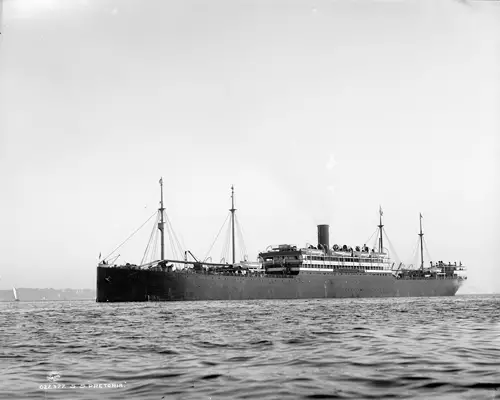
The RMS Pretorian of the Allan Line (1898). Photo Courtesy of the National Archives.
These last, in order of their size, were the Tunisian, Bavarian, and Ionian. The Tunisian was a twin-screw steamer of 10,576 tons, designed by Messrs. Stephen, while the Bavarian was constructed by Denny. These two were almost alike in point of size and accommodation, being 520 ft. long, 60 ft. in beam and 43 ft .deep. They were noted for their large beam ratio,—1 to 8.6. or in other words, their length was eight and two-thirds times their width. This, of course, was conducive to steadiness in rough weather.
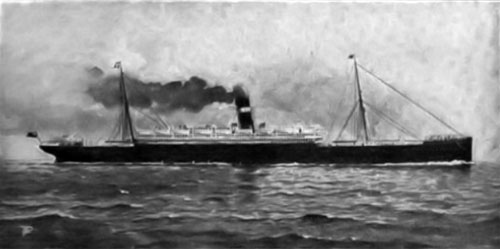
The RMS Tunisian of the Allan Line -- a Twin Screw Steamer
Towards the end of 1904, two of the Company's newest liners were delivered. These were the Virginian and Victorian, of 12,000 tons, or 1,500 tons larger than the Tunisian and Bavarian. The Virginian, which was the first turbine propelled Atlantic steamer, beat all records in August 1905, between Moville and Rimouski, the actual steaming time between the two ports being 5 days 21 hours. The vessel was out of sight of land only 3 days 21 hours.
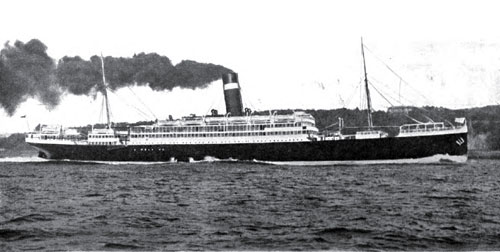
The Allan Line Turbine Steamship RMS Virginian and Victorian. Page's Magazine, October 1904. | GGA Image ID # 20b1183580
Just previous to the outbreak of the war, two magnificent quadruple screw turbine liners of 18,500 tons, were added to the company's fleet, namely, the Alsatian and the Calgarian. The latter was unfortunately torpedoed while serving as an auxiliary British cruiser.
In 1909, the Canadian Pacific Railway acquired a controlling interest in the line, and at a meeting held on July 16, 1917, the fusion of its interests with those of the Canadian Pacific Ocean Services formally took place. Thus, the oldest of the navigation companies in Canadian trade was absorbed by the youngest of its competitors.
Allan Line Management Always Progressive
During its long and honorable career, the Allan Line was noted for being at the forefront of steamship enterprises to adopt improvements. Besides being the pioneer company to install turbines on an Atlantic Ocean vessel, it was also the first to implement flush or covered decks, an innovation which afforded a maximum of safety in rough weather and which speedily commended itself to other lines engaged in the transatlantic trade.
Again, the first Atlantic liner to be built of steel was its unit the Buenos Ayrean. The company was also the first to fit bilge keels to their passenger ships, which are now regarded as an absolutely essential part of the equipment of every ocean-going passenger steamer. Also, it was the first to employ in the Atlantic trade wireless telegraphy for the sending of long distance messages.
Henry Serrano Villard, “Allan Line’s Long and Notable Career,” in The Nautical Gazette, New York, Volume 96, Number 2, Whole Number 2500, July 12, 1919, p 26.
Return to Content Links
Recap & Summary: Allan Line Archival Collection
The Allan Line, one of the most distinguished British-Canadian steamship companies, played a critical role in transatlantic travel and immigration for over a century. Founded in 1819 and expanding throughout the 19th and early 20th centuries, it became the dominant carrier of passengers, cargo, and mail between the United Kingdom, Canada, and the United States.
This archival collection presents a comprehensive history of the Allan Line, featuring passenger lists, immigrant landing cards, menus, tickets, brochures, ship profiles, and historical accounts. The collection is invaluable for genealogists, historians, educators, and maritime enthusiasts, offering unique insights into ocean travel, immigration patterns, and ship technology of the era.
1. The Allan Line’s Expansion and Influence
Transatlantic Routes & Ports of Call
The Allan Line connected major British ports—Glasgow, Londonderry, Belfast, Liverpool, and London—to North American destinations including:
- Canadian Ports: Quebec, Montreal, St. John's, Halifax
- U.S. Ports: Portland, Boston, New York, Philadelphia, Baltimore
The Montreal-Quebec route was one of the shortest transatlantic crossings, reducing travel time compared to New York-based routes.
🔹 Why it’s interesting:
- The Allan Line’s dominance in Canadian immigration helped shape the modern population of Canada, bringing thousands of European settlers.
- The use of the St. Lawrence River route provided a unique alternative to the longer U.S.-bound journeys.
2. Notable Ships of the Allan Line
The Allan Line operated a vast fleet of cutting-edge steamships, many of which became legendary in transatlantic travel.
Key Vessels in the Fleet
- RMS Victorian (1904): The first Atlantic liner powered by a steam turbine, marking a milestone in marine engineering.
- RMS Virginian (1905): A twin to the Victorian, also turbine-powered, known for record-breaking voyages.
- RMS Tunisian (1900): One of the largest and most luxurious Allan liners, providing elite accommodations.
- RMS Alsatian (1914) & RMS Calgarian (1914): Quadruple screw turbine steamers, among the largest and fastest ships on the St. Lawrence route.
- SS Parisian & SS Sardinian (1870s-1880s): Famous for their speed, safety, and role in immigration transport.
🔹 Why it’s interesting:
- The Victorian and Virginian were pioneers in turbine propulsion, a major leap in maritime technology.
- The Tunisian and Alsatian reflected luxury and efficiency, showcasing the evolution of passenger comfort.
- The Parisian and Sardinian transported thousands of immigrants, making them vital to Canadian and American history.
3. Immigration and Passenger Experience
The Allan Line was a primary carrier of immigrants from Europe to North America, offering first-class, second-class, and steerage accommodations.
Accommodations and Travel Conditions
- First-Class Passengers: Luxurious staterooms, elegant dining saloons, and exclusive lounges.
- Second-Class (Intermediate) Passengers: Affordable yet comfortable cabins, with good food and ventilation.
- Steerage Passengers (Immigrants): Basic but remarkably comfortable for the cost, with separate areas for men and families.
- Onboard Services: Medical care, heating, electric lighting, and high-quality food ensured a safe and comfortable journey.
Advertising & Immigration Promotions
The Allan Line actively advertised immigration to Canada, offering:
- Low-cost passage for immigrants, in partnership with the New South Wales Government.
- Excursion tickets with flexible return options.
- Free voyage kits for steerage passengers, including bedding and tableware.
🔹 Why it’s interesting:
- Steerage conditions were better than expected, countering common beliefs about immigrant travel hardships.
- Marketing strategies helped populate Canada, making the Allan Line a key player in nation-building efforts.
4. Technological Innovations & Maritime Advancements
The Allan Line was a leader in marine innovation, often pioneering cutting-edge technology before its competitors.
Notable Maritime Firsts
✅ First to use turbine engines on transatlantic liners (RMS Victorian & RMS Virginian, 1904-1905).
✅ First to install bilge keels, reducing rolling in rough seas.
✅ First steel-built ocean liner (Buenos Ayrean, 1881).
✅ Early adopter of Marconi wireless telegraphy for ship communication.
Speed & Efficiency
- The RMS Virginian set a record-breaking transatlantic voyage in 1905 (5 days, 21 hours).
- The weekly mail service was one of the fastest and most reliable in the world.
🔹 Why it’s interesting:
- The use of turbine technology was groundbreaking, influencing the future of high-speed steamships.
- Innovations in ship stabilization and communication enhanced safety and efficiency at sea.
5. The Allan Line’s Decline and Merger with Canadian Pacific
By 1917, the Allan Line merged with Canadian Pacific Ocean Services (CPOS), marking the end of one of the longest-running transatlantic shipping companies.
Reasons for Decline
- The rise of larger competitors like the White Star Line & Cunard Line.
- Increased competition from railroads and air travel.
- Heavy losses during World War I, including the sinking of the Calgarian.
🔹 Why it’s interesting:
- The merger with Canadian Pacific ensured that its legacy lived on, even as independent operations ceased.
- The demise of the Allan Line reflected broader changes in global transportation and travel habits.
6. Why This Collection is Important
This archival collection is a treasure trove of information, offering rare and detailed documentation about the Allan Line’s impact.
Who Can Benefit from This Collection?
✅ Genealogists – Passenger lists, tickets, and immigration records provide ancestry research material.
✅ Maritime Historians – Ship designs, technological advancements, and detailed accounts of ocean travel.
✅ Teachers & Students – Useful for lessons on Canadian immigration, industrial advancements, and transportation history.
✅ Ship Enthusiasts – Photos, menus, deck plans, and brochures highlight the luxury and mechanics of transatlantic liners.
Conclusion: The Allan Line’s Lasting Legacy
The Allan Line was more than just a steamship company—it was a pillar of transatlantic travel, immigration, and technological advancement.
From its humble beginnings in 1819 to its integration into Canadian Pacific in 1917, it played a crucial role in:
- Shaping Canada’s immigrant population.
- Advancing ship technology and transatlantic speed.
- Providing affordable and comfortable passage for travelers.
Today, the Allan Line’s legacy lives on through the stories preserved in passenger lists, advertisements, ship designs, and historical accounts—a testament to its importance in maritime history.
